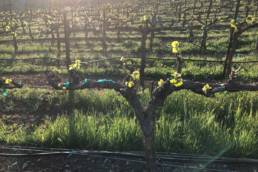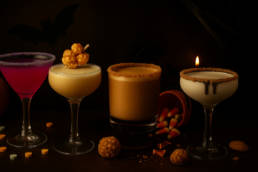Morning News – July 2024 – Wines to Beat the Heat
Instead of incremental increases in our mercury levels, Summer has ungraciously arrived bringing record high temperatures right out of the gate. We all have a favorite way to combat our individual sweltering, (beach, pool, boat, etc.) and prevent our biscuits from roasting like a Thanksgiving turkey. I will not attempt to alter your personal perspiration mitigation but rather enhance your efforts by including some chilled adult beverage selections.
I am fairly certain most people have a “go-to” wine that they pour into their high-tech adult sippy cup before heading out into the heat. I offer an opportunity to, once again, go slightly off your well-trodden beverage path and sample some more “unusual” wines. These selections not only serve as great summer sippers, they have enough interest and complexity to gain a place alongside you favorite warm-weather dishes.
Some of the most interesting white wines are produced in extreme settings. Although it applies to all grapes, the industry refers to these inhospitable conditions as “heroic viticulture.” When I see a region where growing red varieties are difficult or impossible, then I will probably like the white wines produced there. These colder, high-altitude areas seem to give those lively, crisp and complex whites that I yearn for.
Isarco Valley
The Isarco Valley is located in northeastern Italy within the province of Alto Adige. Dividing the Stubai Alps and the Sarntal Alps from the Zillertal Alps and the Dolomites, the valley has been a home for viticulture for a couple millennia. The high-altitude valley vineyards with the stark contrasting backdrop of snow-covered peaks jutting toward the blue sky is truly something to experience.
Abbazia di Novacella remains one of the oldest producers in the region and one of Europe’s oldest working monasteries, home to the Order of the Augustinian Canons. The original land donation that started the monastery in 1142 included a small vineyard. Over the centuries, they have expanded their vineyard area and today continue sourcing grapes from other local growers, some under contract since the 1960s.
Some white varieties produced in this region, and in neighboring Austria, have been relegated to inexpensive quaffable pop-and-drop type of wines. The quality driven production philosophies of this producer have proven that these varieties, like Müller Thurgau, Kerner and Sylvaner can produce interesting, unique, and thought-provoking varietal wines.
My “red-wine-only” crowd seems to fret this time of year as pouring a 15% ETOH, highly extracted red down your gullet as you wipe the sweat from your brow does not seem that appealing. I wholeheartedly concur and invite you to practice a few “warm weather” strategies that will have you swilling your reds with blissful disregard once again.
While consuming my red wine sin climate control, I look for certain qualities to keep my palate from surrendering. Red wines that are lower in alcohol, have finer grained tannin structures, and can be served with a slight chill are in my sweet spot. There would be nothing wrong with a cooler climate Cabernet Franc or Pinot Noir to sip through the summer but the bigger red lovers often seem to turn their noses up to those varieties. For this reason and for the sheer pleasure of introducing you to grapes you may have never tasted, we are going to Austria.
Austrian Reds
Many consumers share the belief that Germany and Austria produce wines from the same grape varieties. Although this statement is mostly true, there are some varieties, especially red, that Austria grows more widely and with greater success. Austria lies slightly south of Germany with a warmer, drier climate allowing their red varieties to ripen much more consistently than their German counterparts.
Sankt Laurent is one such variety that enjoys some plantings in Germany and Central Europe but showing substantial vineyard coverage in Austria, especially in Burgenland and Niederösterreich. Although the origins of St. Laurent are controversial, the grape has been used to breed varieties such as Zweigelt, Rondo, André and Dunaj. Austria viticulture seems to have to overcome its finicky nature as they continue to expand growing area and produce these dark, dense, fruity wines with great success.
Another Austrian variety by birthright is the aforementioned Zweigelt (Rotburger). In 1922, at the Teaching and Research Centre for Viticulture and Horticulture (LFZ) in Klosterneuburg, Professor Fritz Zweigelt crossed Blaufränkisch x St. Laurent to produce this coined “favorite variety” of Austrians.
Initially the variety was not widely adopted due to both impending social issues and the vine’s high fertility, requiring extensive pruning and yield management. Zweigelt only really gained recognition after the Second World War, largely in part due to Lenz Moser, who recommended the variety and planted it extensively using his high vine training system. Reducing yields gave wines of deep color, potentially sturdy tannins and interesting peppered red berry elements. Today, Zweigelt is the most widespread and economically important red wine variety in all of Austria.
As you head out into the summer swelter, add the whites from Alto Adige and reds from Austria to assist in staying cool during your outdoor activities. Not only will these wines travel well to the beach, on your boat, or poolside, they will carry through to accompany a myriad of summer fare. So grab that sippy cup, pour heavy and embrace all that summer has to offer.
Suggested Wines:
Abbazia di Novacella Alto Adige Valle Isarco DOC Sylvaner 2023 $16
The Sylvaner variety originates from Austria and was most likely a natural crossing between Traminer x Österreichisch Weiß. This example has 3/4 of the must ferment and age in stainless steel tanks and 1/4 in 50 hl acacia casks for 6 months. There are aromas of orchard fruit (apple, white peach), apple blossom, sweet hay, a slight mint nuance, and some petrichor. The palate is dry with thirst-quenching acidity that creates a strong backbone for this wine and continues to linger on the finish. There is an evident viscous mouthfeel that helps to tame the perception of the acidity. There are continuations of orchard fruit on the palate with added citrus notes, melon and evident brined minerality. This versatile wine would pair well with both heartier fish (swordfish), chilled lobster or even summer salads.
Abbazia di Novacella Alto Adige Valle Isarco DOC Gruner Veltliner 2023 $16
This classic Austrian grape shows that it can still grow well in areas of the old Austro-Hungarian Empire. There are aromas of green apple, pineapple, cantaloupe, tarragon and that classic white pepper spice. The palate is dry with classic Gruner acid structure; hits up front, disappears in midpalate then crescendos at the finish. The body is viscous, silky and sexy. There are flavors of brined citrus (tangerine, pineapple), tropical (cantaloupe) and a flinty minerality. This remains one of the most versatile varieties for pairing dishes. This wine can go with Austrian classics like wiener schnitzel, vegetal dishes like grilled asparagus or artichoke, and Asian spiced dishes such as spring rolls, dim sum, samosas, and mild Indian curries.
Pittnauer St. Laurent Vom Dorf 2020 Burgenland, Austria $30
This varietal Sankt Laurent ferments and ages in 500L neutral barrels for 12 months. The nose has aromas of tart berry (cherry, raspberry, blackberry), plum, violet, sweet tobacco, and baking spice (all spice). The palate is dry with medium body and a tart crunchy persistent acid structure, and a boastful 12% abv. The tannins are fine grained and well-integrated. There are flavors of tart cherry, blackberry and raspberry covered with dried earthy woody herbs, a dash of baking spice and a subtle hint of smokiness. The finish is clean with the bright acid still dancing with your salivary glands. Pair this with charcuterie plates, Beef Bourguignon, and mushroom risotto.
Weingut Umathum Frauenkirchner Zweigelt 2020 Burgenland, Austria $25
This glass closure Zweigelt matures over two winters without filtration in old oak barrels before bottling. The wine initially showed a good amount of reduction but thankfully blew off after some aeration and time. The nose shows red fruit (cherry, raspberry, red currant), black peppercorn, brambles and a slight floral note. The dry palate has a bright broad acid structure, medium body and a subtle tannin structure. The peppercorn and red fruit carry through to the palate with an added cranberry and smoky note. At 12.5% abv, you can chill this wine to about 65F and consume at leisure. Pair this wine with barbecue, fish dishes with tomato-based sauces, terrine or just a good burger.




